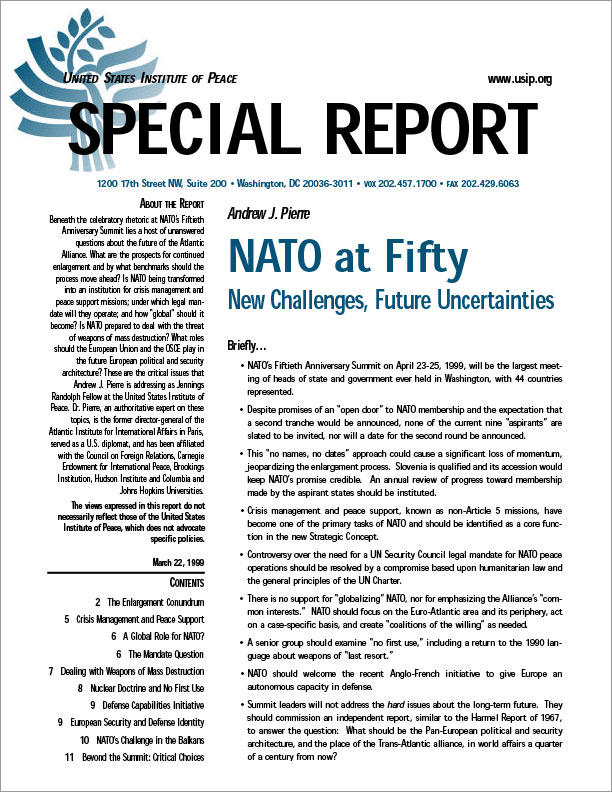
Summary
- NATO's Fiftieth Anniversary Summit on April 23-25, 1999, will be the largest meeting of heads of state and government ever held in Washington, with 44 countries represented.
- Despite promises of an "open door" to NATO membership and the expectation that a second tranche would be announced, none of the current nine "aspirants" are slated to be invited, nor will a date for the second round be announced.
- This "no names, no dates" approach could cause a significant loss of momentum, jeopardizing the enlargement process. Slovenia is qualified and its accession would keep NATO's promise credible. An annual review of progress toward membership made by the aspirant states should be instituted.
- Crisis management and peace support, known as non-Article 5 missions, have become one of the primary tasks of NATO and should be identified as a core function in the new Strategic Concept.
- Controversy over the need for a UN Security Council legal mandate for NATO peace operations should be resolved by a compromise based upon humanitarian law and the general principles of the UN Charter.
- There is no support for "globalizing" NATO, nor for emphasizing the Alliance's "common interests." NATO should focus on the Euro-Atlantic area and its periphery, act on a case-specific basis, and create "coalitions of the willing" as needed.
- A senior group should examine "no first use," including a return to the 1990 language about weapons of "last resort."
- NATO should welcome the recent Anglo-French initiative to give Europe an autonomous capacity in defense.
- Summit leaders will not address the hard issues about the long-term future. They should commission an independent report, similar to the Harmel Report of 1967, to answer the question: What should be the Pan-European political and security architecture, and the place of the Trans-Atlantic alliance, in world affairs a quarter of a century from now?
NATO's Fiftieth Anniversary Summit in Washington, DC, on April 23-25, 1999, will be the largest meeting of heads of state and government ever held in the nation's capital, with 44 countries represented. Not only will the leaders of the Alliance's sixteen nations be joined by those of its three new members, Poland, Hungary, and the Czech Republic, which were formally admitted in March, but also the leaders of the Euro-Atlantic Partnership Council, (EAPC) which includes an additional 25 "partner" nations, will be present. Only the participation of the Russian leadership remains in doubt.
The first session will be commemorative and held, appropriately, in the Mellon Auditorium where on April 4, 1949, the North Atlantic Treaty was signed. Plans will be announced for the construction of a new headquarters building for NATO in Brussels. This is not only a necessity for the enlarging alliance but a fitting symbol of the confidence that NATO, born to respond to a Cold War threat, will have an important future in the new international environment of the twenty-first century. A "vision statement" will be signed, with public and parliamentary audiences in mind, underlining the successful transformation of NATO in the past decade and the continuing need for the Alliance in the years to come.
About the Report
Beneath the celebratory rhetoric at NATO's Fiftieth Anniversary Summit lies a host of unanswered questions about the future of the Atlantic Alliance. What are the prospects for continued enlargement and by what benchmarks should the process move ahead? Is NATO being transformed into an institution for crisis management and peace support missions; under which legal mandate will they operate; and how "global" should it become? Is NATO prepared to deal with the threat of weapons of mass destruction? What roles should the European Union and the OSCE play in the future European political and security architecture? These are the critical issues that Andrew J. Pierre is addressing as Jennings Randolph Fellow at the United States Institute of Peace. Dr. Pierre, an authoritative expert on these topics, is the former director-general of the Atlantic Institute for International Affairs in Paris, served as a U.S. diplomat, and has been affiliated with the Council on Foreign Relations, Carnegie Endowment for International Peace, Brookings Institution, Hudson Institute and Columbia and Johns Hopkins Universities.
The views expressed in this report do not necessarily reflect those of the United States Institute of Peace, which does not advocate specific policies.